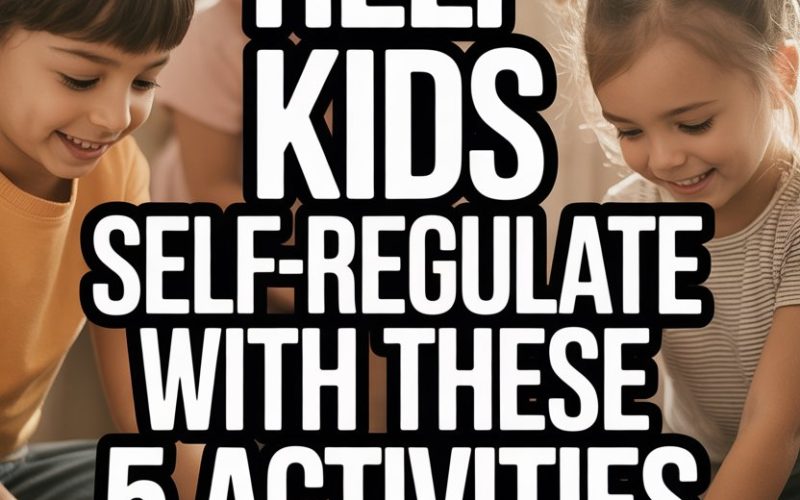Self‑regulation: the unicorn of modern parenting. If you’ve ever watched your child unravel in the cereal aisle, you already know how essential it is—and how elusive it can feel.
Still, with the right activities and a smidge of patience (plus coffee, obviously), kids can build up this life‑changing skill.
Need ideas that fit into your wild, busy schedule? That’s exactly what you’ll find here.
1. Movement Breaks That Don’t Require a PE Degree
Children’s bodies are made to move—preferably when you need them to sit still. Lucky for us, movement is a brilliant way to help with self‑regulation.
Research from the University of Illinois confirms that even short bursts of physical activity help kids manage emotions and attention.
This doesn’t require a Pinterest‑perfect home gym or a teacher’s whistle. Marching like soldiers from the living room to the kitchen, setting up an impromptu scavenger hunt for “things that are blue,” or blasting a song for a two‑minute dance‑off in the hallway—these simple activities can give kids enough of an energy reset to refocus.
Need something even more hands‑off? Simon Says. Works wonders for burning energy and sneaking in a bit of impulse‑control practice, too. Just don’t be surprised if you get roped in.
2. Breathing Games That Actually Work
Telling a child, “Take a deep breath!” when they’re mid‑tantrum often results in… an even louder tantrum. But breathing exercises can be effective if you make them playful.
Try “Smell the Flower, Blow Out the Candle.” Hold up your fingers—one is the flower, one is the candle. Ask your child to take a long sniff (through the nose) of the imaginary flower, then blow out the candle with a slow, steady exhale.
Doing this a few times can help even very young children calm their bodies, since it activates the parasympathetic nervous system—science‑speak for “turns down the alarm bells.”
Bubble blowing works, too (and who doesn’t love bubbles?). Slow, controlled exhales create bigger, better bubbles, giving children immediate feedback and making breath‑work feel like magic. The best kind of trickery.
3. Mindful Jar Activities
A glitter jar is like a snow globe for the soul. Fill a clean jar with water, a dash of clear glue, and a healthy sprinkle of glitter. When it’s shaken, the swirling sparkles are a visual metaphor for big feelings. As the glitter settles, so can your child.
This isn’t just a Pinterest fever dream: mindfulness activities like this have been backed up by Harvard Health Publishing, which shows that even short stints of mindful observation can help kids notice and manage emotions rather than act on them.
If you’re not up for glue and glitter (no judgement), a snow globe or even a jar of rice with a few hidden beads will do. The key is to watch, wait, and breathe.
For bonus points, you can narrate the process: “Wow, look how the glitter is slowing down. Our feelings can do that, too.”
4. Story Time With a Twist
Stories are more than just bedtime fillers or last‑minute attempts to avoid screen time. When stories are interactive, they become a brilliant tool for emotional regulation.
Pick tales where characters face big feelings—anger, disappointment, excitement. Pause and ask, “How do you think she felt when her tower fell over?” or “What could he do to feel better?” This helps your child identify emotions and brainstorm coping strategies, building emotional literacy.
Bonus: The Zones of Regulation framework offers storybooks and games specially designed for teaching self‑regulation, if you’re after a structured approach.
5. Sensory Stations for Little (and Not‑So‑Little) Hands
Never underestimate the power of something squishy, stretchy, or crunchy. Sensory play calms frazzled nerves and helps children check in with their own bodies.
Sensory bins filled with rice, beans, or water beads are easy to throw together, and Occupational Therapy International research suggests this sort of play supports attention and emotional control.
On the go? A stress ball or a piece of putty in a jacket pocket can work wonders when waiting in line or sitting in traffic. Even chewing crunchy foods (think apple slices or crackers) can help ground kids in the present and decrease overwhelm.
For the overworked parent who can’t face another clean‑up session, try a “feely bag”: toss random household objects into a small bag and challenge your child to guess what’s inside, using only their hands.
Why Self‑Regulation Doesn’t Have to Be a Chore
Children aren’t born knowing how to hit pause on big feelings—honestly, plenty of grown‑ups are still working on it.
With a little creativity and a few go‑to activities, you can help your child practise this skill in ways that feel more like play than punishment.
Busy parents don’t need more guilt or impossible standards. What matters is trying, showing up, and remembering every meltdown is a chance to teach—not just survive.
Next time the wheels start to come off at tea time, try out one of these tricks (and maybe give yourself a gold star, too). Self‑regulation isn’t built in a day, but every small step counts.





